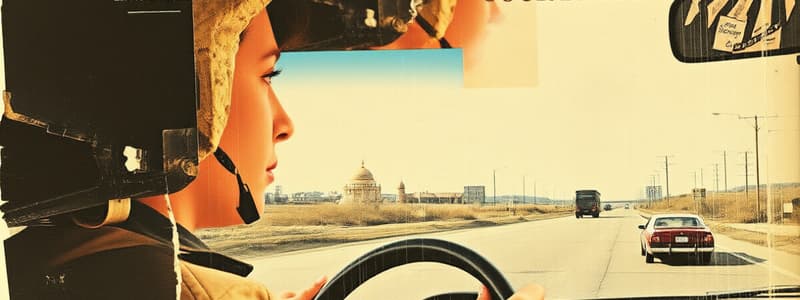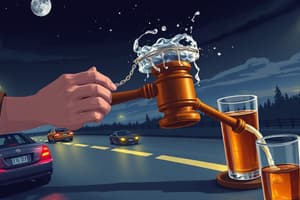Podcast
Questions and Answers
Teenage drivers are more likely to be involved in a crash when:
Teenage drivers are more likely to be involved in a crash when:
- They are driving with adult passengers.
- They are driving alone.
- They are driving with teenage passengers. (correct)
- They are driving at night.
What is a consequence of drivers who eat and drink while driving?
What is a consequence of drivers who eat and drink while driving?
They have trouble controlling their vehicles.
What are preparing to smoke and smoking while driving considered?
What are preparing to smoke and smoking while driving considered?
Distracting activities.
What is the top major crash type for 16-year-old drivers in Pennsylvania?
What is the top major crash type for 16-year-old drivers in Pennsylvania?
When passing a bicyclist, what should you do?
When passing a bicyclist, what should you do?
What should you expect when driving through an area where children are playing?
What should you expect when driving through an area where children are playing?
If you are driving behind a motorcycle, what must you do?
If you are driving behind a motorcycle, what must you do?
How much following distance should you allow when traveling behind a motorcycle?
How much following distance should you allow when traveling behind a motorcycle?
Why should you use extra caution when driving near a pedestrian using a white cane?
Why should you use extra caution when driving near a pedestrian using a white cane?
What should you do when driving near a blind pedestrian carrying a white cane or using a guide dog?
What should you do when driving near a blind pedestrian carrying a white cane or using a guide dog?
Who must yield when a driver is turning and a pedestrian is crossing without a traffic light?
Who must yield when a driver is turning and a pedestrian is crossing without a traffic light?
What does an orange triangle on the back of a vehicle indicate?
What does an orange triangle on the back of a vehicle indicate?
At night, what is hardest to see?
At night, what is hardest to see?
When a truck driver behind you wants to pass, what should your speed do?
When a truck driver behind you wants to pass, what should your speed do?
What should you remember when sharing the road with a truck?
What should you remember when sharing the road with a truck?
If you stop at a railroad crossing with more than one track, what should you do?
If you stop at a railroad crossing with more than one track, what should you do?
What is very dangerous to do if you are following a truck that swings left before making a right turn?
What is very dangerous to do if you are following a truck that swings left before making a right turn?
When do you not have to stop for a school bus whose red lights are flashing?
When do you not have to stop for a school bus whose red lights are flashing?
What must you do when a school bus has its lights flashing and its stop arm extended?
What must you do when a school bus has its lights flashing and its stop arm extended?
What should you do after a train has passed?
What should you do after a train has passed?
If you need to slow down or stop when other drivers may not expect it, what should you do?
If you need to slow down or stop when other drivers may not expect it, what should you do?
When planning to make a turn, when should you activate your turn signals?
When planning to make a turn, when should you activate your turn signals?
Before passing another vehicle, what should you do?
Before passing another vehicle, what should you do?
What is your blind spot?
What is your blind spot?
Before passing another vehicle, how early should you signal?
Before passing another vehicle, how early should you signal?
Before changing lanes on a multi-lane highway, what should you do?
Before changing lanes on a multi-lane highway, what should you do?
When you park on the roadway, what should you use?
When you park on the roadway, what should you use?
Before backing up, what should you do?
Before backing up, what should you do?
To help avoid crashes, what should you do?
To help avoid crashes, what should you do?
What does the driver indicate when they are slowing or stopping?
What does the driver indicate when they are slowing or stopping?
If your turn signals fail, what should you use to indicate you are turning?
If your turn signals fail, what should you use to indicate you are turning?
When traveling below 40 miles per hour on a limited access highway, what should you do?
When traveling below 40 miles per hour on a limited access highway, what should you do?
When should you honk your horn?
When should you honk your horn?
You must use your headlights when other vehicles are not visible from ________ feet away.
You must use your headlights when other vehicles are not visible from ________ feet away.
Flashcards are hidden until you start studying
Study Notes
Teenage Drivers
- Teenage drivers are at higher risk of crashes, especially when accompanied by teenage passengers.
Driving Distractions
- Eating and drinking while driving can impair vehicle control.
- Smoking and preparing to smoke are also major distractions.
Common Crash Types
- The most frequent crash for 16-year-old drivers in Pennsylvania involves single vehicle/run-off-the-road incidents.
Bicyclists and Pedestrians
- Always move far left when passing a bicyclist to ensure safety.
- Expect children playing to potentially run into traffic unexpectedly.
- When following a motorcycle, maintain a full lane and a following distance of at least 4 seconds.
- Exercise extra caution around pedestrians using white canes, as they are blind.
- Slow down and be prepared to stop near blind pedestrians with white canes or guide dogs.
Driver Responsibilities
- Drivers must yield to pedestrians crossing without traffic lights.
- An orange triangle on a vehicle signals it drives slower than normal traffic.
- At night, pedestrians become the hardest to see.
Truck Interactions
- Maintain a steady or reduced speed when a truck is attempting to pass.
- Trucks require longer distances than cars to stop, necessitating caution on the road.
Railroad and School Bus Protocol
- At multi-track railroad crossings, wait until both tracks are clear before proceeding.
- Refrain from squeezing between a truck and curb when a truck swings left for a right turn.
- Stop at least 10 feet away from a school bus with flashing red lights and extended stop arm, except on the opposite side of a divided highway.
Safety Procedures
- After a train passes, check for other trains before proceeding.
- To signal intent to slow down or stop unexpectedly, quickly tap your brake pedal to alert trailing drivers.
- Turn signals should be activated 3 to 4 seconds before reaching an intersection.
Lane Changes and Parking
- Signal appropriately before changing lanes and check mirrors and blind spots.
- Use four-way flashers when parking on a roadway.
Backing Up and Defensive Driving
- Look through the rear window and turn your head before backing up.
- Communicate your intentions to other drivers to help avoid crashes.
Indicators of Driver Actions
- Slowing or stopping vehicles can be indicated by brake lights.
Signal Failures
- If turn signals fail, hand signals should be used to indicate turns.
Speed Regulations
- Utilize four-way flashers when traveling below 40 mph on a limited access highway.
Horn Use
- Honk your horn to alert when a child is about to run into the street.
Visibility Guidelines
- Use headlights when vehicles are not visible from a significant distance; specifics may vary but the guideline emphasizes safety.
Studying That Suits You
Use AI to generate personalized quizzes and flashcards to suit your learning preferences.




